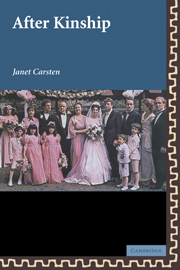Book contents
- Frontmatter
- Contents
- Acknowledgments
- 1 Introduction: After Kinship?
- 2 Houses of Memory and Kinship
- 3 Gender, Bodies, and Kinship
- 4 The Person
- 5 Uses and Abuses of Substance
- 6 Families into Nation : The Power of Metaphor and the Transformation of Kinship
- 7 Assisted Reproduction
- 8 Conclusion
- Bibliography
- Index
2 - Houses of Memory and Kinship
Published online by Cambridge University Press: 05 June 2012
- Frontmatter
- Contents
- Acknowledgments
- 1 Introduction: After Kinship?
- 2 Houses of Memory and Kinship
- 3 Gender, Bodies, and Kinship
- 4 The Person
- 5 Uses and Abuses of Substance
- 6 Families into Nation : The Power of Metaphor and the Transformation of Kinship
- 7 Assisted Reproduction
- 8 Conclusion
- Bibliography
- Index
Summary
For many people, the memories of houses inhabited in childhood have an extraordinary evocative power. Perhaps this is attributable to the dense and myriad connections that link together what goes on in houses – processes of feeding and nurturance, the emotionally charged social relations of close kinship, and repetitive bodily practice through which many rules of social life are encoded – quite apart from their more practical, material, and aesthetic dimensions.
My own powerful “house memories” focus on a large kitchen table at which not only cooking and eating but also most family discussions, communal homework, and many games took place. This was the warm, at times overheated, hearth of a house, which combined, in curious ways, elements of an early twentieth century Central European, bourgeois, Jewish culture with the unconventionalities of left-wing bohemianism of the 1930s and of the postwar London intelligentsia. The house had a distinctly old-fashioned air, or at least an “out of time” quality, which no doubt partly resulted from my parents' uprooting from Nazi Germany and their subsequent dislike of change for its own sake. The enormous and often chilly “living room” was home to an ill-assorted collection of somewhat ponderous antique furniture and paintings. It presumably expressed rather accurately the tastes of a solid upper-middle-class home in 1920s Berlin. Needless to say, very little living actually took place there; this was a space reserved for special occasions and rather formal dinner parties.
- Type
- Chapter
- Information
- After Kinship , pp. 31 - 56Publisher: Cambridge University PressPrint publication year: 2003
- 1
- Cited by



